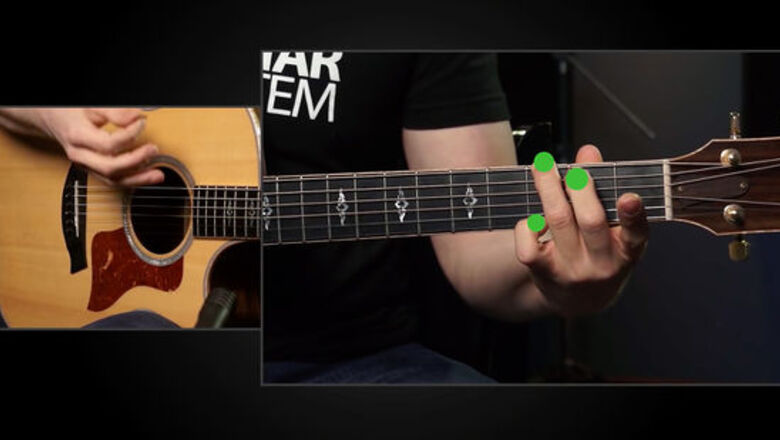
views
X
Research source
Knowing the Essential Chords

Learn a G major. Place your ring finger on the top string (the sixth string), on the third fret. Your middle finger goes a string below on the second fret. Then use your pinky to play the third fret on the lowest, thinnest string (the first string). You can also play this chord with your index, middle, and ring fingers, though it is harder to transition to other chords like this. Strum all strings. --3-- --0-- --0-- --0-- --2-- --3--
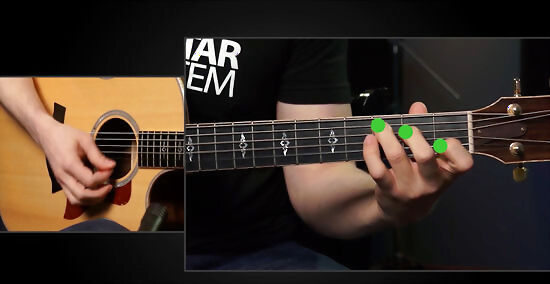
Learn a C major. Your fingers form a diagonal line up towards your face. Your ring finger is on the fifth string (the A string), third fret. Your middle is on the third string, second fret, and the index goes down on the second string, first fret. --0-- --1-- --0-- --2-- --3-- --0--
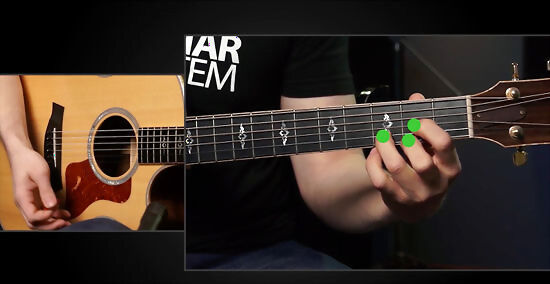
Learn a D major. Place your index finger on the third string, second fret. Place your middle finger on the first string, second fret, then finally lay your ring finger on the second string, third fret. You'll have a little triangle with your fingers on the bottom three strings. You only strum the bottom four strings. --2-- --3-- --2-- --0-- --x-- --x--

Learn an E major and minor. Place your second finger (middle) on the second fret of the A string. Place your ring finger down on the second fret of the D string. Finally, place your index finger on the first fret of the G string, the third string from the bottom. --0-- --0-- --0-- --2-- --2-- --0-- Make an E-major chord by simply adding your index finger on the third string, first fret.
Learning Simple Four-Chord Songs

Purchase a capo to make it easier to sing or adjust pitch. A capo clamps down on all six strings, allowing you to play these chords anywhere on the neck. Basically, wherever the capo goes becomes the new "0" in your chords. This allows you to keep the same shape and play songs in any key. The following songs have a capo in them, but you can still play them without one. Note, however, that the songs will sound off-key from recorded versions.
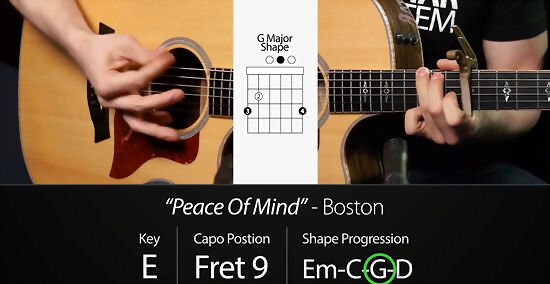
Play Boston's "Piece of Mind" with a capo on the ninth fret. This great little riff sounds good electric or acoustic. It has a fast rhythm to it -- one strum on the first and third chords, two on the second and forth. If you can throw in some muted notes, even better. Capo: 9th Chord Shape Progression: Em - C - G - D
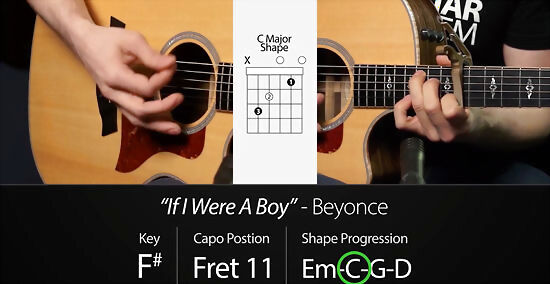
Play Beyonce's "If I Were a Boy." A slower tempo song, this sounds great on acoustic. Simply strum down four times on each chord. It is just a slower version of the Boston song. Capo: 11th Chord Shape Progression: Em - C - G - D
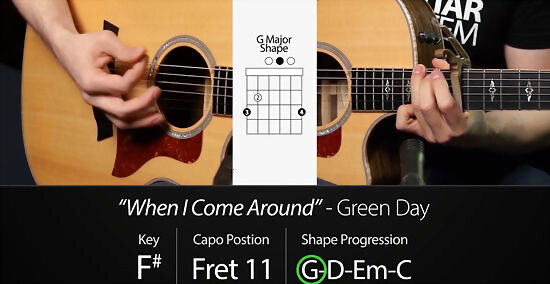
Play Green Day's "When I Come Around." Simple and easy, play four strums on the first two chords. Then strum the third chord twice, once coming up with the pick. Then play the final chord four times. Capo: 11th Chord Shape Progression: G - D - Em - C
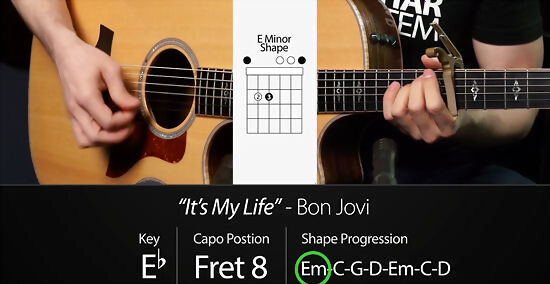
Play Bon Jovi's "It's My Life." Play eight driving, quick strums on each chord, or four sets of up/down strumming. Keep this consistent beat (these are eighth notes) going. Capo: 8th Chord Shape Progression: Em - C - G - D - Em - C - D
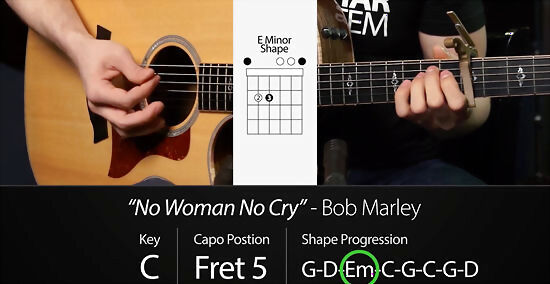
Play Bob Marley's "No Woman No Cry." This requires a simple reggae "up-stroke" pattern. Only play the chord by picking upwards, towards your face. As your hand comes back down, lift your fingers slightly off the chord so you get a muted "chick" as you strum down the guitar, towards your feet. Capo: 5th Chord Shape Progression: G - D - Em - C - G - C - G - D
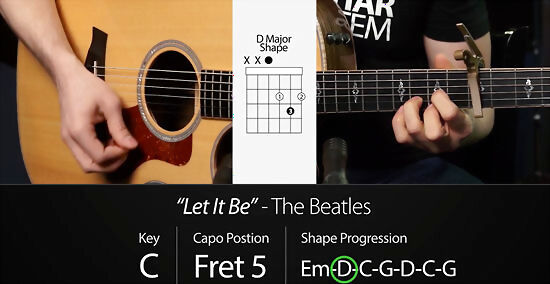
Play The Beatles "Let it Be." Just like Bon Jovi's song, you just need gentle, calm strums. For each measure ("1 and, 2 and, 3 and, 4 and, 1 and..."), you want to strum on the "1," pause, the strum twice for the "2 and." Play the "3," pause, then strum twice for the "4 and." Capo: 5th Chord Shape Progression: Em - D - C - G - D - C - G
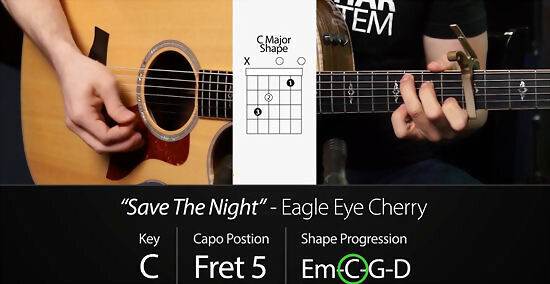
Play Eagle Eye Cherry's "Save the Night.: Simple and easy, strum it like normal for the entire bar, but hit the last chord, right before you switch, harder and louder. Capo: 5th Chord Shape Progression: Em - C - G - D

Play Aerosmith's "Cryin'." The strumming is simple and basic -- three up/down strums for each chord. Capo: 2nd Chord Shape Progression: G - D - Em - C - G - D - C.
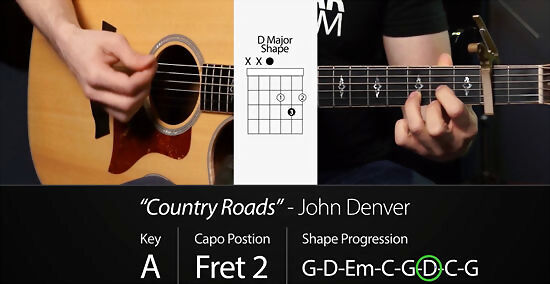
Play John Denver's "Country Roads." Another simple, folksy strum pattern. At the beginning of every measure, just strum the top string of the chord to get a nice, bouncy feel to the song. Capo: 2nd Chord Shape Progression: G - D - Em - C - G - D - C - G
Play Joan Osborne's "One of Us." This final song has a few nifty tricks in it to push your guitar skills, but you can skip them if you're still practicing. To get the intro riff, you use all the same notes in your normal chords. When transitioning chords, simply keep the last three strings in place for 1 measure. So, going from the D to the Em, leave the bottom three strings as a D for the first strum of Em, then lift them. Capo: 2th Chord Shape Progression: D - Em - C - G - D - Em - C - G - D Taylor Swift Taylor Swift, Singer & Businesswoman Practice diligently to improve your skills. "I have to practice to be good at guitar. I have to write 100 songs before I write the first good one."




















Comments
0 comment